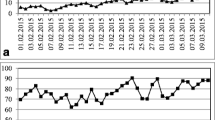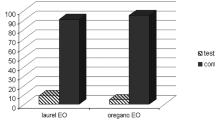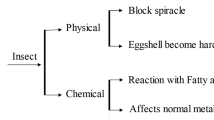Abstract
Oviposition deterrents are the info-chemicals that modifies the behavior of conspecific female insects either to settle on the treated surface or to lay eggs thereafter, reducing intra-specific competition. Drawing from our prior research, it has been established that the fatty acids (Oleic and linoleic acid) found in vegetable oils exhibit properties of oviposition deterrence. The present study was designed to investigate the oviposition deterrent activity of vegetable oils against pink bollworm. Six different vegetable oils, namely groundnut, sunflower, soybean, rice bran, safflower and sesame containing oleic and linoleic acid as major fatty acids were selected and evaluated under laboratory and field conditions. Under laboratory conditions, oils were tested at concentrations ranging from 0.5 to 3.0%, with methanol as control. Cotton twigs with squares served as the oviposition substrate and the total number of eggs laid by the moth was counted and compared to control. The results demonstrated a significant reduction in number of eggs laid as evident from the avoidance index (AI) and percent effective deterrence (PED) values of vegetable oil treatments. Descending order of oviposition deterrent efficacy as revealed from AI and PED values, groundnut (AI = 0.74, PED = 84.40%) > soybean (0.67, 79.87%) > sesame (0.65, 78.59%) > sunflower (0.59, 74.09%) > rice bran (0.57, 71.93%) > safflower (0.55, 71.09%). Our findings were further validated through field studies conducted during 2019–2020 and 2020–2021, confirming effectiveness of the selected vegetable oils in reducing the boll damage. Study demonstrates the promising oviposition deterrent effect of vegetable oils against Pectinophora gossypiella and hold great potential as an eco-friendly component in integrated pest management program of cotton.

Similar content being viewed by others
References
Beattie GAC, Lru M, Watson DM, Clift AD, Jiang L (1995) Evaluation of petroleum spray oils and polysaccharides for control of Phyllocnists citrella Stainton (Lepidoptera: Gracillaridae). Aust J Entomol 34:349–353
Byers JA, Naranjo SE (2014) Detection and monitoring of pink bollworm moths and invasive insects using pheromone traps and encounter rate models. J Appl Ecol 51:1041–1049
Daniel D (2014) Rhagoletis cerasi: oviposition reduction effects of oil products. Insects 5:319–331
Desneux N, Decourtye A, Delpuech JM (2007) The sublethal effects of pesticides on beneficial arthropods. Annu Rev Entomol 52:81–106
Dhurua S, Gujar GT (2011) Field-evolved resistance to Bt toxin Cry1Ac in the pink bollworm, Pectinophora gossypiella (Saunders) (Lepidoptera: Gelechiidae), from India. Pest Manag Sci 67:898–903
Erler F (2004) Oviposition deterrency and deterrent stability of some oily substances against the pear psylla Cacopsylla pyri. Phytoparasitica 32:479–485
Erler F, Tosun HS (2017) Plant oils as oviposition deterrents against winterform females of pear psylla, Cacopsylla pyri (L.) (Hemiptera: Psyllidae). Phytoparasitica 45:509–515
Fabrick JA, Ponnuraj J, Singh A, Tanwar RK, Unnithan GC, Yelich AJ, Li X, Carrière Y, Tabashnik BE (2014) Alternative splicing and highly variable cadherin transcripts associated with field-evolved resistance of pink bollworm to Bt cotton in India. PLoS ONE 9(5):e97900. https://doi.org/10.1371/journal.pone.0097900
Fand BB, Nagrare VS, Gawande SP, Nagrale DT, Naikwadi BV, Deshmukh V, Gokte-Narkhedkar N, Waghmare VN (2019) Widespread infestation of pink bollworm, Pectinophora gossypiella (Saunders) (Lepidoptera: Gelechidae) on Bt cotton in Central India: a new threat and concerns for cotton production. Phytoparasitica 47:313–325
Fand BB, Nagrare VS, Deshmukh V, Naikwadi BV, Gokte-Narkhedkar N, Waghmare VN (2020) A simple & low-cost laboratory rearing technique for cotton pink bollworm, Pectinophora gossypiella (Suanders) (Lepidoptera: Gelechidae) using detached green bolls of cotton. Phytoparasitica 48:25–33
Fenigstein A, Eliyahu M, Gan-Mor S, Veierov D (2001) Effects of five vegetable oils on the sweet potato whitefly, Bemisia tabaci. Phytoparasitica 29:197–206
Fernandez DE, Beers EH, Brunner JF, Doerr M, Dunley JE (2001) Mineral oil inhibition of white apple leafhopper (Homoptera: Cicadellidae) oviposition. EntomolSci 36:237–243
Freitas G, Santos MC, Lira V, Galvao A, Oliveira E, Filho JGS, Teodoro A (2018) Acute and non-lethal effects of coconut oil on predatory mite Typhlodromus ornatus (Acari: Phytoseiidae). Syst Appl Acarol 23:1333–1341
Hidayat Y, Heather N, Hassan E (2014) Mechanism and effectiveness of safflower oil against female Queensland fruit fly Bactrocera tryoni. Entomol Exp Appl 152:175–181
Kumar R, Kranthi S, Nagrare VS, Monga D, Kranthi KR, Rao N, Singh A (2019) Insecticidal activity of botanical oils and other neem-based derivatives against whitefly, Bemisia tabaci (Gennadius) (Homoptera: Aleyrodidae) on cotton. Int J Trop Insect Sci 39:203–210
Li G, Ishikawa Y (2004) Oviposition deterrents in larval frass of four Ostrinia species fed on an artificial diet. J Chem Ecol 30:1445–1456
Li G, Ishikawa Y (2005) Oviposition deterrents from the egg masses of adzuki bean borer, Ostrinia scapulalis and Asian corn borer. O Furnacalis Entomol Exp Appl 115:401–407
Liu ZM, Beattie GAC, Johnson D, Spooner-Hart R (2002) Influence of deposits of a horticultural mineral oil and selected fractions of paraffinic and naphthenic petroleum-derived oils on oviposition by Queensland fruit fly on tomato fruit. In: Beattie GAC, Watson DM, Stevens ML, Rae DJ, Spooner-Hart RN (eds) Spray oils beyond 2000. University of Western Sydney, NSW, Australia, pp 142–146
Lu Y, Wyckhuys KAG, Yang L, Liu B, Zeng J, Jiang Y, Desneux N, Zhang W, Wu K (2022) Bt cotton area contraction drives regional pest resurgence, crop loss, and pesticide use. Plant Biotechnol J 20:390–398
Madhu TN, Mohan KM (2022) Effect of host plants on the oviposition preference of pink bollworm, Pectinophora gossypiella (Lepidoptera: Gelechiidae). Anim Bio 72:15–25
Mensah RK, Frerot B, Al Dabel F (2005) Effect of petroleum spray oils on ovipositionbehaviour and larval survival of Helicoverpa armigera and Ostrinia nubilalis. Int J Pest Manag 51:111–119
Naik VCB, Kumbhare S, Kranthi S, Satija U, Kranthi KR (2018) Field-evolved resistance of pink bollworm, Pectinophora gossypiella (Saunders) (Lepidoptera: Gelechiidae), to transgenic Bacillus thuringiensis (Bt) cotton expressing crystal 1Ac (Cry1Ac) and Cry2Ab in India. Pest Manag Sci 74:2544–2554
Oliveira NN, Galvao AS, Amaral EA, Santos AW, Sena-Filho JG, Oliveira EE, Teodoro AV (2017) Toxicity of vegetable oils to the coconut mite Aceria guerreronis and selectivity against the predator Neoseiulus baraki. Exp Appl Acarol 72:23–34
Pande R, Shah V, Verma P (2019) First report on identification of volatiles from egg and larval Frass of Indian strain of the American bollworm Helicoverpa armigera (Hübner). Afr Entomol 27:403
Pande R, Shah V, Verma P, Gokte-Narkhedkar N, Waghmare VN (2022) Improved bioassay method for evaluation of oviposition deterrents against Old World bollworm, Helicoverpa armigera (Hübner). Indian J Exp Biol 60:851–857
Pavela R, Herda G (2007) Repellent effects of pongam oil on settlement and oviposition of the common greenhouse whitefly Trialeurodes vaporariorum on chrysanthemum. Insect Sci 14:219–224
R Core Team R (2021) A language and environment for statistical computing. R Foundation for Statistical Computing, Vienna, Austria. URL https://www.R-project.org/.
Rae DJ, Beattie GAC, Watson DM, Liu ZM, Jiang L (1996) Effects of petroleum spray oils without and with copper fungicides on the control of citrus leaf miner, Phyllocnistis citrella Stainton. (Lepidopter: Gracillaridae). Aust J Entomol 35:247–251
Rae DJ, Liang WG, Watson DM, Beattie GAC, Huang MD (1997) Evaluation of petroleum spray oils for control of the Asian citrus psylla, Diaphorina citri (Kuwayama) (Hemiptera: Psyllidae) in China. Int J Pest Manag 43:71–75
Rahman A, Talukder FA (2006) Bioefficacy of some plant derivatives that protect grain against the pulse beetle, Callosobruchus maculatus. J Insect Sci 6:1–10
Rajkumar S, Jebanesan A (2009) Larvicidal and oviposition activity of Cassia obtusifolia Linn (Family: Leguminosae) leaf extract against malarial vector, Anopheles stephensi Liston (Diptera: Culicidae). Parasitol Res 104:337–340
Ramya RS, Mohan M, Joshi S (2020) A simple method for sexing live larvae of pink bollworm, Pectinophora gossypiella (Lepidoptera: Gelechiidae). Anim Biol 70:97–100
Renwick JAA, Radke CD (1980) An oviposition deterrent associated with frass from feeding larvae of the cabbage looper, Trichoplusia ni (Lepidoptera: Noctuidae). Environ Entomol 9:318–320
Riedl H, Halaj J, Kreowski WB, Hilton RJ, Westigard PH (1995) Laboratory evaluation of mineral oils for control of codling moth (Lepidoptera: Tortricidae). J Econ Entomol 88:140–147
Shah V, Pande R, Verma P, Gokte-Narkhedkar N, Waghmare VN (2020) Identification of oviposition deterrents from pink bollworm, Pectinophora gossypiella (Saunders). J Environ Biol 41:644–649
Shah V, Pande R, Fand BB, Gokte-Narkhedkar N, Waghmare VN (2021) Innovative on-plant bioassay method for selection of superior genotype/cultivar/event against pink bollworm, Pectinophora gossypiella (Saunders) in cotton in protected screen house condition. Int J Trop Insect Sci 41:3167–3172
Shah V, Pande R, Verma P, Gokte-Narkhedkar N, Prasad YG (2022) Oviposition preference of pink bollworm, Pectinophora gossypiella on cotton. Anim Biol 72:353–366
Shah V, Pande R, Verma P, Prabhulinga T, Madhu TN, Gokte-Narkhedkar N, Waghmare VN (2023) Fatty acids for insect species remain constant: a case study, Pink bollworm, Pectinophora gossypiella (Saunders). Animbiol 73:141–151
SPSS (2007) Inc. SPSS for windows, Released version 16.0. Chicago, SPSS Inc.
Sridhar J, Naik VCB, Ghodke A, Kranthi S, Kranthi KR, Singh BP, Choudhary JS, Krishna MSR (2017) Population genetic structure of cotton pink bollworm, Pectinophora gossypiella (Saunders) (Lepidoptera: Gelechiidae) using mitochondrial cytochrome oxidase I (COI) gene sequences from India. Mitochondrial DNA Part A 28:941–948
Xu H, Li G, Liu M, Xing G (2006) Oviposition deterrents in larval frass of the cotton boll worm, Helicoverpa armigera (Lepidoptera: Noctuidae): chemical identification and electro antennography analysis. J Insect Physiol 52:320–326
Acknowledgements
The authors are thankful to Indian Council of Agricultural Research, New Delhi and Director, ICAR- CICR, Nagpur. The authors are also thankful to former Director and former Head, Division of Crop Protection, for all the support and guidance. We thank all the technical help and guidance in carrying out this experiment.
Funding
Not applicable.
Author information
Authors and Affiliations
Corresponding author
Ethics declarations
Conflict of interests
The authors declare that they have no known competing financial interests or personal relationships that could have appeared to influence the work reported in this paper.
Additional information
Publisher's Note
Springer Nature remains neutral with regard to jurisdictional claims in published maps and institutional affiliations.
Rights and permissions
Springer Nature or its licensor (e.g. a society or other partner) holds exclusive rights to this article under a publishing agreement with the author(s) or other rightsholder(s); author self-archiving of the accepted manuscript version of this article is solely governed by the terms of such publishing agreement and applicable law.
About this article
Cite this article
Shah, V., Pande, R., Verma, P. et al. Evaluation of vegetable oil as oviposition deterrents for the management of pink bollworm, Pectinophora gossypiella (Saunders) in cotton. J Plant Dis Prot 131, 403–412 (2024). https://doi.org/10.1007/s41348-023-00837-2
Received:
Accepted:
Published:
Issue Date:
DOI: https://doi.org/10.1007/s41348-023-00837-2




